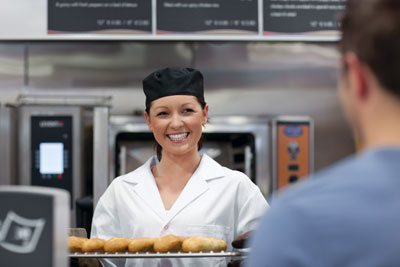
Romancing the sweets
October 25, 2012
By Michelle Brisebois
Each and every one of us has a unique weak spot when it comes to spending money.
Each and every one of us has a unique weak spot when it comes to spending money. Whatever your passion, you will likely opt to spend a bit more to get the calibre and quality of item you covet, even though comparable and less expensive products are available. When we really look at luxury marketing, it becomes clear that people aren’t just paying a premium for the item – it’s the story they buy into. So, you must determine how to train your customer-facing staff to embrace and tell the stories around your products.
 |
|
| Train your customer-facing staff to share their knowledge about your products.
|
Baked goods do fall into the category of luxury marketing. They are considered to be a small indulgence. As such, the same successful tactics used by a fine jewelry shop could easily be adapted for your business too. Consumers are beginning to prefer experiences to products. Rather than acquire more possessions, customers are more interested in spending their money and time on meaningful experiences, making memories and enriching their lives. According to research by the Boston Consulting Group published in 2012, experiential luxury now makes up almost 55 per cent of total luxury spending worldwide and, year after year, has grown 50 per cent faster than sales of luxury goods. In China, where sales of luxury goods are growing 22 per cent each year, the experiential luxury market is growing at 28 per cent per year. It’s easy to see the financial upside to introducing a little retail theatre, but you may have a customer-facing team of diligent, trustworthy people who find the notion of romancing the product daunting. Is it possible to turn them into showmen overnight?
When you’re hiring customer-facing people, you should look for those who have a natural curiosity and are able to hold a conversation. If they’re too chatty, you run the risk of them being too familiar with the customers. Do they ask questions at the interview? If so, chances are they will enjoy learning about the products and processes. Do they listen when you speak and do they seem to like people? The quieter team members can still be very effective at describing the product – it’s simply a matter of helping them find their groove within the context of their comfort zone. Tell your team that you need them to not only take orders, but also share their knowledge. It’s about adding value to the customer experience.
The next step is to invest in extensive product training. It can be a challenge to get everyone together when many work part-time on different days, but an hour-long training session once per month to showcase the new products and discuss ingredients could be a great investment in your labour cost. Post a corkboard in the kitchen where you can display labels from ingredients used and write-ups to describe your baked goods. You can send team members e-mail updates with product information as well. Large food companies always have fact sheets that describe the product and give weights, nutritional information and ingredients. You can do the same for your menu.
Put some of the new products out pre-shift and take 10 minutes to conduct structured tastings. If the celebrity ingredient is an exotic spice or chocolate, give everyone a piece of the raw material to smell and feel, asking them to focus on its origin, mouth texture and why it makes a difference to the final product. Ask them to taste together in silence and then to write their own tasting notes as they think about the flavours. As a group, share the notes and see what familiar themes arise. All of these points will provide the base for beautiful stories when talking to customers.
Elements of Persuasion, a book by Robert Dickman and Richard Maxwell, proposes that a story is “a fact wrapped in an emotion that compels us to take an action.” Customers want the story because it enhances their anticipation of a delicious experience to come. The story prolongs the pleasure of the experience. Anthropologists hypothesize that absorbing information via verbal stories is hard-wired into us. For most of our existence on this planet, humans have obtained their most important information, life skills and religion, among other things, through stories. Some experts believe our brain is wired to ensure that storytelling has a much stronger emotional impact than information that’s presented with less emotion. Using the tasting notes your team has already created, you can have them role-play their storytelling at the next staff meeting. Have a contest with a prize to see who can tell the most impactful story about each baked good. The story should revolve around the ingredients (origin, freshness and taste) of the product, as well as how it was created (the artistry). The pièce de résistance should be a description of how it tastes and perhaps a recommendation for a garnish or coffee pairing.
Finally and most importantly, tell your team to enjoy the process and to make sure that their stories are authentic and natural. The stereotypical used-car salesmen get a bad rap because they’re seen as disingenuous. It’s about believability, or, as Mark Twain once said, “Don’t tell fish stories where the people know you; but particularly, don’t tell them where they know the fish.”
Michelle Brisebois is a marketing professional with experience in the food, pharmaceutical, financial services and wine industries. She specializes in retail brand strategies.
Print this page
Leave a Reply